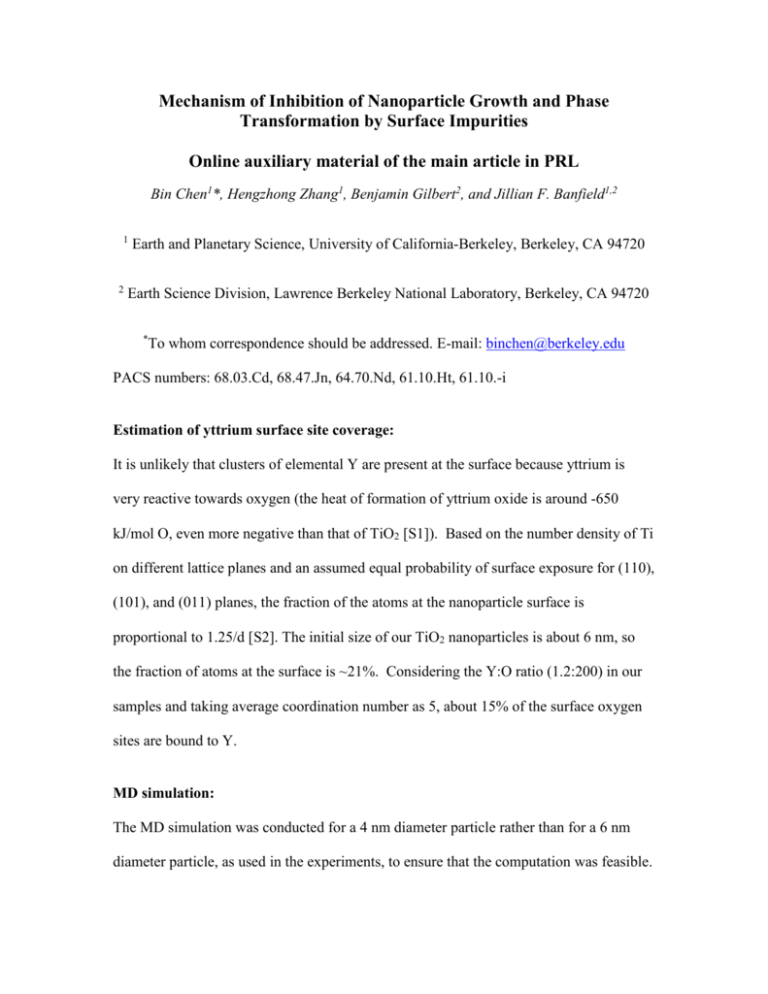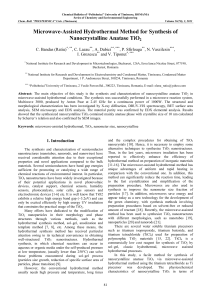Mechanism of Inhibition of Nanoparticle Growth
advertisement

Mechanism of Inhibition of Nanoparticle Growth and Phase Transformation by Surface Impurities Online auxiliary material of the main article in PRL Bin Chen1*, Hengzhong Zhang1, Benjamin Gilbert2, and Jillian F. Banfield1,2 1 2 Earth and Planetary Science, University of California-Berkeley, Berkeley, CA 94720 Earth Science Division, Lawrence Berkeley National Laboratory, Berkeley, CA 94720 * To whom correspondence should be addressed. E-mail: binchen@berkeley.edu PACS numbers: 68.03.Cd, 68.47.Jn, 64.70.Nd, 61.10.Ht, 61.10.-i Estimation of yttrium surface site coverage: It is unlikely that clusters of elemental Y are present at the surface because yttrium is very reactive towards oxygen (the heat of formation of yttrium oxide is around -650 kJ/mol O, even more negative than that of TiO2 [S1]). Based on the number density of Ti on different lattice planes and an assumed equal probability of surface exposure for (110), (101), and (011) planes, the fraction of the atoms at the nanoparticle surface is proportional to 1.25/d [S2]. The initial size of our TiO2 nanoparticles is about 6 nm, so the fraction of atoms at the surface is ~21%. Considering the Y:O ratio (1.2:200) in our samples and taking average coordination number as 5, about 15% of the surface oxygen sites are bound to Y. MD simulation: The MD simulation was conducted for a 4 nm diameter particle rather than for a 6 nm diameter particle, as used in the experiments, to ensure that the computation was feasible. The atomic interaction functions given by Matsui and Akaogi were chosen for TiO2 [S3]. This set of potential functions has been previously shown to well reproduce the lattice parameters, bulk modulii and other physical properties of the polymorphs of TiO2 [S4]. For the yttrium-oxygen interaction in anatase, we have chosen the interatomic potential function designed by Lewis and Catlow for use in ionic oxides and mixed oxides [S5]. The initial configuration was constructed as follows: A 4nm anatase particle was cut from the coordinates of bulk anatase, and then 16 randomly chosen Ti atoms on the near surface layer were substituted by 16 Y atoms. While assuming no clustering of yttrium atoms, the whole nanoparticle was made neutral by removing extra O or Ti atoms, resulting in the MD particle containing 16 Y, 990 Ti and 2004 O atoms (i.e. molar Y:Ti = 1.6 %). The MD simulation was carried out in a canonical assemble (constant number of atoms, volume, and temperature) at 300 K, with a time step of 0.01 fs for a length of 63 ps. At this MD timescale, the nanoparticle was fully structurally relaxed to a low-energy state. Figure S1 (Color online): Fourier transform magnitude of k3-weighted Y K-edge EXAFS spectra of yttrium-doped TiO2 nanoparticles as a function of treatment temperature. Inset: A representative one of the k3-weighted first-shell EXAFS spectra (solid green line) and the fit (dashed red line). Figure S2 (Color online): The fit (dashed red) of a representative pair distance function of yttrium-doped TiO2 nanoparticles (solid green). References Cited in the Supplemental Online Material: [S1] U. Diebold, Surf. Sci. Rep. 48, 53 (2003). [S2] L. X. Chen et al., J. Phys. Chem. B 101, 10688 (1997). [S3] M. Matsui and M. Akaogi, Mol. Simul. 6, 239 (1991). [S4] P. K. Naicker et al., J. Phys. Chem. B 109, 15243 (2005). [S5] G.V. Lewis and C. R. A. Catlow, J. Phys. C 18, 1149 (1985).






![Preparation of TiO[subscript 2] Anatase Nanocrystals by](http://s2.studylib.net/store/data/012436173_1-6ade312d4179e1fbe488fa87e26cb301-300x300.png)